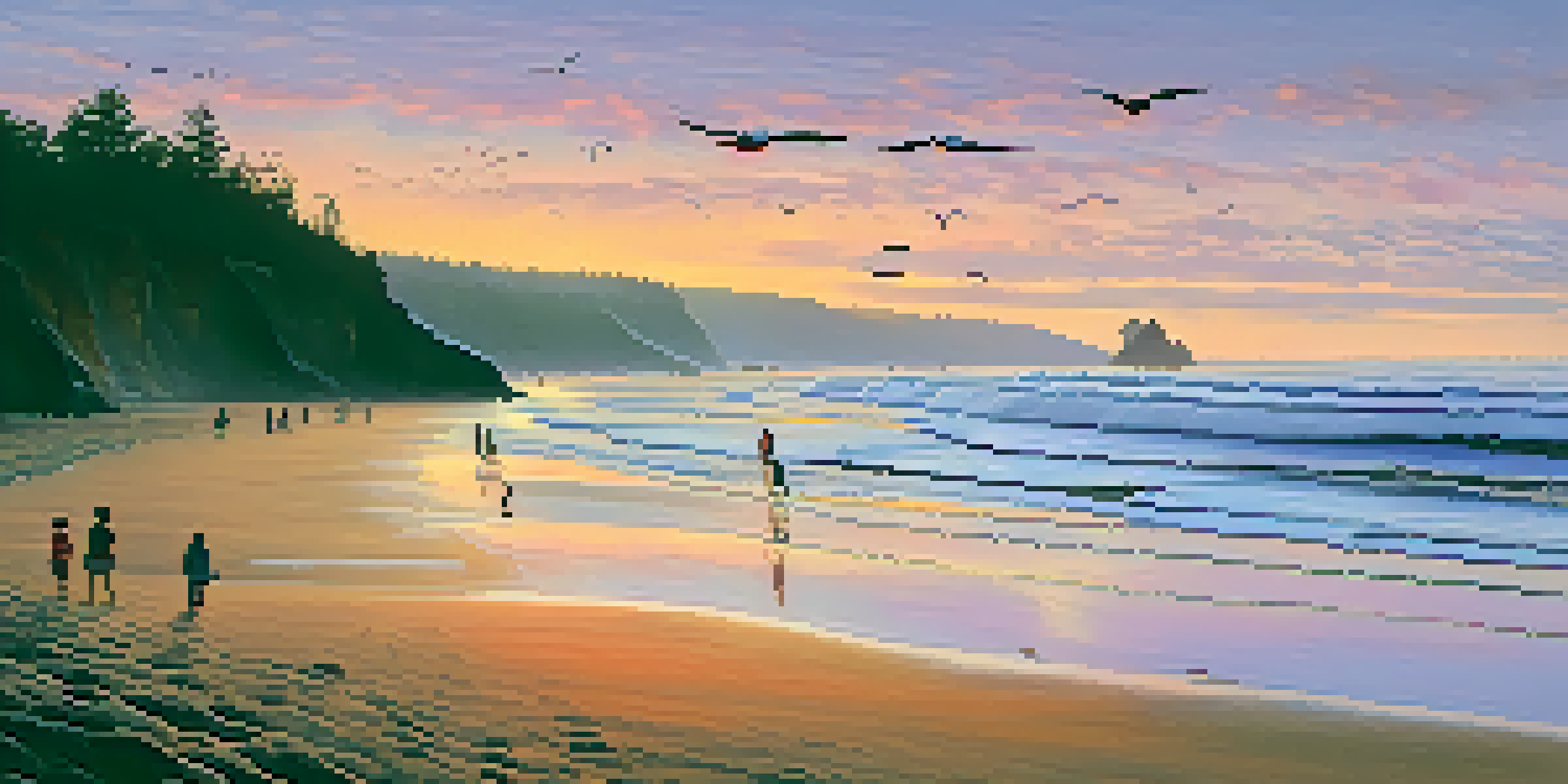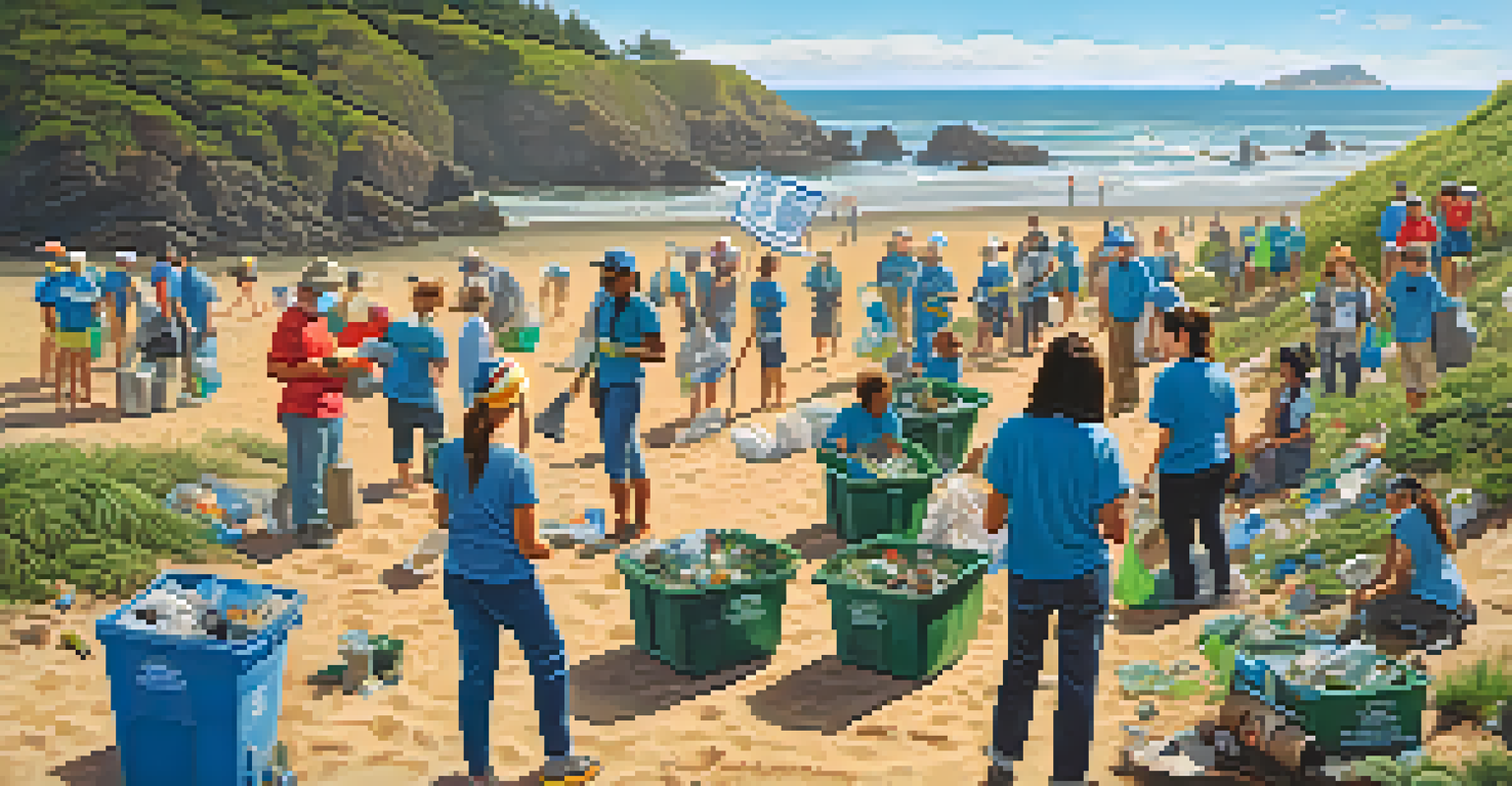Coastal Ecosystems: Protecting Oregon's Shores and Wildlife

Understanding Oregon's Rich Coastal Ecosystems
Oregon's coastline is a vibrant tapestry of ecosystems, where land meets the sea. From sandy beaches to rocky cliffs, these habitats support a diverse range of wildlife, including seabirds, marine mammals, and countless fish species. Each ecosystem plays a crucial role in maintaining the health of our environment, providing food, shelter, and breeding grounds for various species.
The environment is where we all meet; where we all have a mutual interest; it is the one thing all of us share.
The coastal waters are equally important, serving as nurseries for young fish and habitat for marine life like sea stars and sea urchins. These interconnected ecosystems contribute to the overall biodiversity of the region, which is vital for ecological balance. Understanding these relationships helps us appreciate the complexity and fragility of our coastal environments.
By recognizing the significance of these ecosystems, we can take proactive steps to protect them. Engaging in conservation efforts ensures that future generations will enjoy the natural beauty and ecological benefits of Oregon's coastline.
Threats to Oregon's Coastal Ecosystems
Despite their beauty and importance, Oregon's coastal ecosystems face numerous threats. Climate change is causing rising sea levels and increased storm intensity, which disrupts habitats and threatens wildlife. Additionally, pollution from land runoff and ocean debris poses a serious risk to marine life, impacting food sources and breeding grounds.

Human activities, such as coastal development and overfishing, further strain these fragile ecosystems. As more people flock to the coast for recreation and living, the natural balance is often overlooked. This can lead to habitat destruction and a decline in species populations, making it crucial for us to address these challenges.
Importance of Coastal Ecosystems
Oregon's coastal ecosystems are vital for biodiversity, providing essential habitats for a wide range of wildlife.
To combat these threats, it’s essential to implement sustainable practices and policies that prioritize ecosystem health. By focusing on responsible development and pollution reduction, we can help preserve Oregon's natural heritage for years to come.
The Role of Conservation Organizations
Various conservation organizations play a pivotal role in protecting Oregon's coastal ecosystems. These groups work tirelessly to raise awareness, engage communities, and advocate for policies that safeguard wildlife and habitats. Their efforts often include restoration projects, educational programs, and research initiatives aimed at understanding the impacts of human activity on these ecosystems.
In every walk with nature one receives far more than he seeks.
One notable example is the Oregon Coast Aquarium, which not only educates the public about marine life but also participates in research and conservation efforts. They collaborate with local communities to promote responsible practices that minimize environmental impact. Such organizations foster a sense of stewardship among residents and visitors alike.
By supporting these conservation efforts, we can contribute to the preservation of Oregon's coastal ecosystems. Volunteering, donating, or simply spreading the word about their initiatives can make a significant difference in protecting our shores and wildlife.
Community Involvement in Coastal Protection
Community involvement is crucial for the protection of Oregon's coastal ecosystems. Local residents and organizations can take action through beach clean-ups, educational workshops, and citizen science projects. These initiatives not only help maintain the coastline but also foster a sense of connection to the environment, encouraging sustainable practices.
For instance, many communities host annual events aimed at removing debris from beaches and educating participants about the impact of pollution on marine life. Such hands-on experiences allow individuals to see the direct effects of their efforts, which can inspire ongoing commitment to conservation.
Threats to Coastal Environments
Climate change, pollution, and human activities pose significant risks to the health of Oregon's coastal ecosystems.
By working together, communities can amplify their impact and advocate for policies that protect their local ecosystems. When people unite for a common cause, they can create lasting change that benefits both wildlife and future generations.
The Importance of Sustainable Tourism
Sustainable tourism is essential for preserving Oregon's coastal ecosystems while allowing people to enjoy their beauty. By promoting eco-friendly practices, tourists can minimize their impact on the environment, ensuring that natural habitats remain intact. This includes simple actions like staying on designated paths and respecting wildlife.
Many local businesses are embracing sustainable practices, offering eco-tours and promoting conservation-minded activities. For example, guided kayak tours can provide unique experiences while educating participants about marine ecosystems and responsible behavior. Such initiatives help visitors understand the importance of preserving these environments.
When tourism is approached sustainably, it can generate funds for conservation efforts while simultaneously raising awareness about the fragility of coastal ecosystems. Everyone has a role to play in ensuring that Oregon's shores remain a treasured destination for years to come.
Educational Initiatives for Coastal Awareness
Education is a powerful tool for fostering appreciation and understanding of Oregon's coastal ecosystems. Schools and organizations often implement programs that teach students about marine biology, conservation, and the importance of biodiversity. These initiatives can include field trips, hands-on activities, and interactive workshops that ignite curiosity about the natural world.
Moreover, educational resources such as online courses and community seminars help inform the public about the challenges facing coastal ecosystems. Knowledge empowers individuals to take action, whether through volunteering, advocacy, or simply making environmentally conscious choices in their daily lives.
Community Role in Conservation
Active community involvement through clean-ups and educational initiatives is crucial for protecting Oregon's coastal ecosystems.
By investing in education, we cultivate a generation of stewards who value and protect Oregon's coastal treasures. When people understand the ecosystems around them, they are more likely to become advocates for their preservation.
Future Directions for Coastal Conservation
Looking ahead, the future of Oregon's coastal ecosystems depends on collaborative efforts among government, organizations, and communities. Innovative conservation strategies that incorporate scientific research and traditional ecological knowledge can lead to more effective management practices. This holistic approach ensures that diverse perspectives are considered in decision-making processes.
Additionally, ongoing monitoring of ecosystems is vital to assess the impacts of climate change and human activity. By utilizing technology, such as drones and remote sensing, researchers can gather valuable data to inform conservation strategies. This proactive approach allows for timely interventions that can mitigate potential threats.

Ultimately, the future of Oregon's shores and wildlife hinges on our collective commitment to protect and preserve these invaluable ecosystems. Together, we can create a sustainable path forward that honors the beauty and diversity of coastal life.